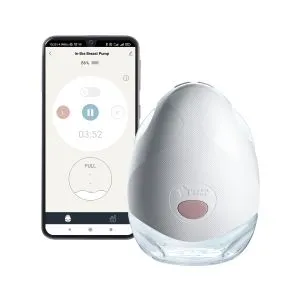Making a bottle with expressed breast milk
If you're going to give your baby breast milk in a sterile bottle, you'll need a breast pump (or to be able to express by hand), and some sterile pouches to store your expressed milk in the fridge or freezer.
Making a formula bottle
When making a bottle of formula you should always carefully follow the preparation instructions, and always use sterile water that's been boiled and left to cool to no less than 70°C.
It's worth noting that too much water can dilute the formula, meaning your baby won't get the optimal amount of nutrition from their feed, and too much formula can lead to constipation and dehydration.
Only make up a formula feed when needed, and make one feed at a time, never in bulk.
A Tommee Tippee Perfect Prep® machine means no boiling. No cooling. Less waiting. And less to clean up.
These bottle prep machines are scientifically proven to make a fresh feed safely, and up to 10x faster than a kettle*.
*For verification see tommeetippee.com/perfect-prep-explained.
Top bottle feeding tips
Let's run through some helpful tips to keep in mind when bottle feeding.
Six is the magic number
If your baby isn't taking to their bottle right away, it can be tempting to keep buying and trying until you find one they accept, but six tries of the same bottle are likely to be as successful as trying six different bottles.
Don't be disheartened and try to persevere with the bottle you think is closest to a breast in shape and movement. Tommee Tippee bottle teats are made from soft silicone and have a special breast-like shape that encourages a natural latch.
Check the temperature of the milk
If your baby likes a warm bottle, you can use an electric bottle warmer to heat their feed, then, use the inside of your wrist to test a few drops before you feed them. If it's a comfortable temperature (not too hot or cold), you're good to go.
While lots of babies like their feeds at body temperature (36.5–37.5°C), it's worth noting that not all babies need their milk to be warm. You can try them with cool milk first to see if they'll take it.
Get comfortable
When bottle-fed lying down babies can take too much milk too quickly, so it's important to sit with them close to you in a semi-upright position. And supporting your baby’s head while they feed means they can swallow and breathe comfortably.
Remember, you should never leave your baby alone to feed with a propped-up bottle as they may choke on the milk.
Gently introduce the bottle teat
Brushing your baby's lips with the bottle teat stimulates their gaping or mouth-opening reflex. Once they've opened their mouth wide, you should let them draw in the teat at their own pace, just like they would when breastfeeding.
Position the bottle horizontally
Once the teat is in your baby's mouth, keep the bottle tipped in a horizontal position so that the milk can flow steadily. This helps prevent them from ingesting air and means that they need to suck actively to get the milk (like they would when breastfeeding).
Always tilt the bottle so the teat is full of milk. You'll need to tip it higher as the bottle slowly drains.
If you notice that the teat gets blocked and goes flat mid-feed, gently pull on the corner of your baby's mouth to release the latch and replace the old teat with a new sterile one.
Follow your baby's feeding cues
Some babies want to feed more often than others, and your baby will let you know how much milk they need. It's best to feed your baby when they seem hungry. Follow their lead and don't worry if they don't finish their full bottle. This is often called paced bottle feeding.
Talk and sing to your baby
Talking and singing to your baby while bottle feeding will help to calm you both and can create a really powerful emotional bond.
Dispose of unused milk
Even though it may seem like a waste, you should discard any unused milk that's left over after a bottle feed. This is because bacteria can get into the milk while your baby is feeding, and if left, this could make them unwell.











